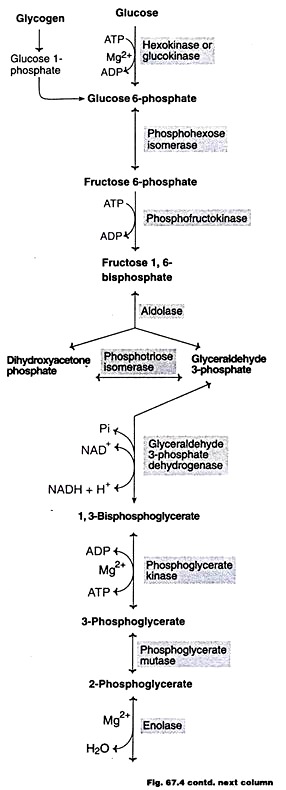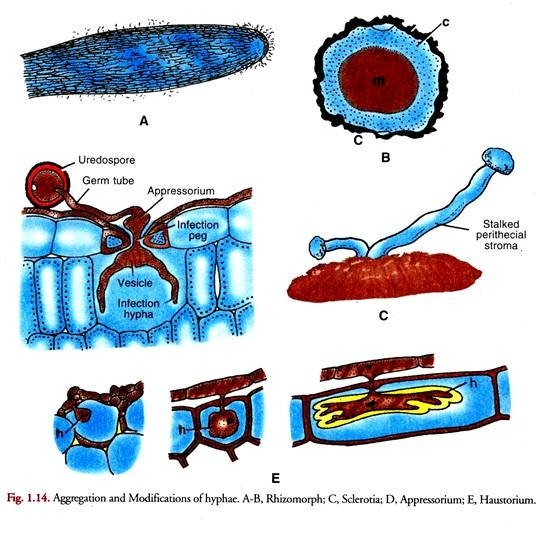This article throws light upon the ten major pathways/cycles of carbohydrate metabolism. The ten pathways/cycles of carbohydrate metabolism are:
(1) Glycolysis (2) Conversion of Pyruvate to Acetyl COA (3) Citric Acid Cycle (4) Gluconeogenesis (5) Glycogen Metabolism (6) Glycogenesis (7) Glycogenolysis (8) Hexose Monophosphate Shunt (9) Glyoxylate Cycle and (10) Photosynthesis.
Carbohydrates are the major source of energy for the living cells. The monosaccharide glucose is the central molecule in carbohydrate metabolism since all the major pathways of carbohydrate metabolism are connected with it (Fig. 67.3).
Glucose is utilized as a source of energy, it is synthesized from non-carbohydrate precursors and stored as glycogen to release glucose as and when the need arises. The other monosaccharide’s important in carbohydrate metabolism are fructose, galactose and mannose.
The fasting blood glucose level in normal humans is 60-100 mg/dl (4.5-5.5 mmol/l) and it is very efficiently maintained at this level.
The outlines of major pathways/cycles of carbohydrate metabolism are described:
Cycle # 1. Glycolysis:
Glycolysis is derived from the Greek words (glycose—sweet or sugar; lysis—dissolution). It is a universal pathway in the living cells. Glycolysis is defined as the sequence of reactions converting glucose (or glycogen) to pyruvate or lactate, with the production of ATP (Fig. 67.4).
Salient features:
1. Glycolysis (also known as Embden-Meyerhof pathway) takes place in all cells of the body. The enzymes of this pathway are present in the cytosomal fraction of the cell.
2. Glycolysis occurs in the absence of oxygen (anaerobic) or in the presence of oxygen (aerobic). Lactate is the end product under anaerobic condition. In the aerobic condition, pyruvate is formed, which is then oxidized to CO2 and H2O.
3. Glycolysis is a major pathway for ATP synthesis in tissues lacking mitochondria, e.g. erythrocytes, cornea, lens etc.
4. Glycolysis is very essential for brain which is dependent on glucose for energy. The glucose in brain has to undergo glycolysis before it is oxidized to CO2 and H2O.
5. Glycolysis (anaerobic) may be summarized by the net reaction
Glucose + 2ADP + 2Pi → 2 Lactate + 2ATP
6. Reversal of glycolysis along with the alternate arrangements made at the irreversible steps will result in the synthesis of glucose (gluconeogenesis).
Cycle # 2. Conversion of Pyruvate to Acetyl COA:
Pyruvate is converted to acetyl CoA by oxidative decarboxylation. This is an irreversible reaction, catalysed by a multi-enzyme complex, known as pyruvate dehydrogenase complex (PDH), which is found only in the mitochondria. High concentrations of PDH are found in cardiac muscle and kidney. The enzyme PDH requires five cofactors (coenzymes), namely — TPP, lipoamide, FAD, coenzyme A and NAD+ (lipoamide contains lipoic acid linked to ɛ-amino group of lysine).
The overall reaction of PDH is:
Cycle # 3. Citric Acid Cycle:
The citric acid cycle (Krebs cycle or tricarboxylic acid—TCA cycle) is the most important metabolic pathway for the energy supply to the body. About 65-70% of the ATP is synthesized in Krebs cycle. Citric acid cycle essentially involves the oxidation of acetyl CoA to CO2 and H2O.
The citric acid cycle is the final common oxidative pathway for carbohydrates, fats and amino acids. This cycle not only supplies energy but also provides many intermediates required for the synthesis of amino acids, glucose, heme etc. Krebs cycle is the most important central pathway connecting almost all the individual metabolic pathways (either directly or indirectly). The enzymes of TCA cycle are located in mitochondrial matrix, in close proximity to the electron transport chain.
Krebs cycle basically involves the combination of a two carbon acetyl CoA with a four carbon oxaloacetate to produce a six carbon tricarboxylic acid, citrate. In the reactions that follow, the two carbons are oxidized to CO, and oxaloacetate is regenerated and recycled. Oxaloacetate is considered to play a catalytic role in citric acid cycle. The reactions of Krebs cycle are depicted in Fig. 67.5.
Cycle # 4. Gluconeogenesis:
The synthesis of glucose or glycogen from non-carbohydrate compounds is known as gluconeogenesis. The major substrates/precursors for gluconeogenesis are lactate, pyruvate, glucogenic amino acids, propionate and glycerol.
Location of gluconeogenesis:
Gluconeogenesis occurs mainly in the cytosol, although some precursors are produced in the mitochondria. Gluconeogenesis mostly takes place in liver and, to some extent, in kidney matrix (about one-tenth of liver capacity).
Reactions of gluconeogenesis:
Gluconeogenesis closely resembles the reversed pathway of glycolysis, although it is not the complete reversal of glycolysis. Essentially, 3 (out of 10) reactions of glycolysis are irreversible. The seven reactions are common for both glycolysis and gluconeogenesis. The three irreversible steps of glycolysis are catalysed by the enzymes, namely hexokinase, phosphofructokinase and pyruvate kinase.
Cycle # 5. Glycogen Metabolism:
Glycogen is the storage form of glucose in animals, as is starch in plants. It is stored mostly in liver (6-8%) and muscle (1-2%). Due to more muscle mass, the quantity of glycogen in muscle (250 g) is about three times higher than that in the liver (75 g).
Functions of glycogen:
The prime function of liver glycogen is to maintain the blood glucose levels, particularly between meals. Liver glycogen stores increase in a well-fed state which are depleted during fasting. Muscle glycogen serves as a fuel reserve for the supply of ATP during muscle contraction.
Cycle # 6. Glycogenesis:
The synthesis of glycogen from glucose is glycogenesis. Glycogenesis takes place in the cytosol and requires ATP and UTP, besides glucose.
Cycle # 7. Glycogenolysis:
The degradation of stored glycogen in liver and muscle constitutes glycogenolysis. The pathway for the synthesis and degradation of glycogen are not reversible. An independent set of enzymes present in the cytosol carry out glycogenolysis. Glycogen is degraded by breaking α-1, 4- and α-1, 6-glycosidic bonds.
Cycle # 8. Hexose Monophosphate Shunt:
Hexose monophosphate pathway or HMP shunt is also called pentose phosphate pathway or phosphogluconate pathway. This is an alternative pathway to glycolysis and TCA cycle for the oxidation of glucose. However, HMP shunt is more anabolic in nature, since it is concerned with the biosynthesis of NADPH and pentose’s.
Location of the pathway:
The enzymes of HMP shunt are located in the cytosol. The tissues such as liver, adipose tissue, adrenal gland, erythrocytes, testes and lactating mammary gland, are highly active in HMP shunt. Most of these tissues are involved in the biosynthesis of fatty acids and steroids which are dependent on the supply of NADPH.
Reactions of HMP shunt:
The sequence of reactions of HMP shunt is depicted in Fig. 67.6.
Significance of HMP shunt:
HMP shunt is unique in generating two important products—pentose’s and NADPH—needed for the biosynthetic reactions and other functions.
A. Importance of pentose’s:
In the HMP shunt, hexoses are converted into pentose’s, the most important being ribose 5-phosphate. This pentose or its derivatives are useful for the synthesis of nucleic acids (RNA and DNA) and many nucleotides such as ATP, NAD+, FAD and CoA.
B. Importance of NADPH:
1. NADPH is required for the reductive biosynthesis of fatty acids and steroids, hence HMP shunt is more active in the tissues concerned with lipogenesis, e.g. adipose tissue, liver etc.
2. NADPH is used in the synthesis of certain amino acids involving the enzyme glutamate dehydrogenase.
3. There is a continuous production of H2O2 in the living cells which can chemically damage unsaturated lipids, proteins and DNA. This is, however, prevented to a large extent through antioxidant reactions involving NADPH. Glutathione mediated reduction of H2O2 is given hereunder
Glutathione (reduced, GSH) detoxifies H2O2, peroxidase catalyses this reaction. NADPH is responsible for the regeneration of reduced glutathione from the oxidized one.
Cycle # 9. Glyoxylate Cycle:
The animals, including man, cannot carry out the net synthesis of carbohydrate from fat. However, the plants and many microorganisms are equipped with the metabolic machinery—namely the glyoxylate cycle—to convert fat into carbohydrates. This pathway is very significant in the germinating seeds where the stored triacylglycerol (fat) is converted to sugars to meet the energy needs.
The glyoxylate cycle is regarded as an anabolic variant of citric acid cycle and is depicted in Fig. 67.7.
Cycle # 10. Photosynthesis:
The synthesis of carbohydrates in green plants photosynthesis. It is now recognized that photosynthesis primarily involves the process of energy transduction in which light energy is converted into chemical energy (in the form of oxidizable carbon compounds).
It is an established fact that all the energy consumed by the biological systems arises from the solar energy that is trapped in the photosynthesis. The basic equation of photosynthesis is given below.
In the above equation, (CH2O) represents carbohydrate. Photosynthesis in the green plants occurs in the chloroplasts, a specialized organelles. The mechanism of photosynthesis is complex, involving many stages, and participation of various macromolecules and macromolecules.
The role of photosystems:
The initial step in the photosynthesis is the by assimilation of carbon dioxide is referred to as absorption of light by chlorophyll molecules in the chloroplasts. This results in the production of excitation energy which is transferred from one chlorophyll molecule to another, until it is trapped by a reaction center. The light-activated transfer of an electron to an acceptor (photosystems) occurs at the reaction center.
Photosynthesis primarily requires the interactions of two distinct photosystems (I and II). Photosystem I generates a strong reductant that results in the formation of NADPH. Photosystem II produces a strong oxidant that forms O2 from H2O. Further, the generation of ATP occurs as electrons flow from photosystem II to photosystem I (Fig. 67.8). Thus, light is responsible for the flow of electrons from H2O to NADPH with a concomitant generation of ATP.
The Calvin cycle:
The dark phase of photosynthesis is referred to as Calvin cycle. In this cycle, the ATP and NADPH produced in the light reaction (described above) are utilized to convert CO2 to hexoses and other organic compounds (Fig. 67.9). The Calvin cycle starts with a reaction of CO2 and ribulose 1, 5-bisphosphate to form two molecules 3-phosphoglycerate. This 3-phosphoglycerate can be converted to fructose 6-phosphate, glucose 6-phosphate and other carbon compounds.







